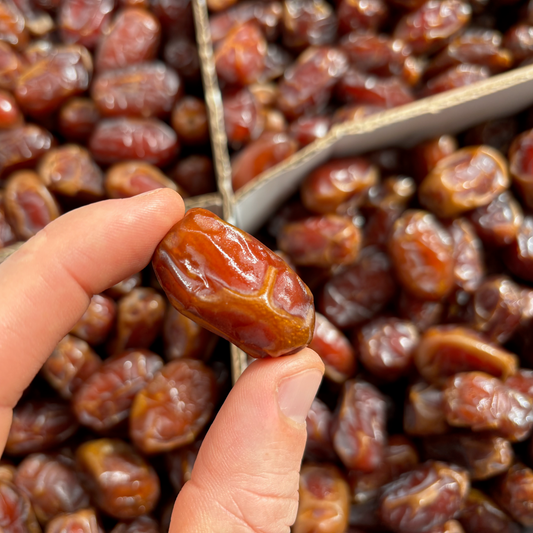fruit notes
It’s POG week – a special time when California-grown passion fruit, orange, and guava overlap in season. It’s the combo of all three flavors that can take your taste buds on an adventure of tropical bliss. When I think of POG, I immediately picture Hawaiian Sun’s Pass-O-Guava juice—those iconic 12-ounce cans of sugary, fruity goodness. But the blend itself has deeper roots, dating back to the early 1970s in Maui, when Haleakala Dairy introduced the now-famous mix of passion fruit, orange, and guava juice. To promote the new product, they distributed old-fashioned collectible cardboard milk caps featuring "POG" and an odd fuzzy mascot. The name "POG" caught on, but it truly took off in the ’80s when Hawaiian kids started playing the popular milk cap game with those cardboard chips. (Yes, POG is the origin of 80's and 90's sensation pogs!)
For me, POG is a flavor associated with Hawaii, so it’s very cool to have this combo with California fruit! The spring passion fruit harvest at Condor Ridge Ranch in Goleta is just underway as the fruit starts to plump up and go from green to purple. Guava at Garcia Organic Farm are becoming more limited as we near the end of the season, but with a few days on the counter they still become as fragrant as ever. And end-of-season oranges are sweet, but Honey Murcott mandarins are even sweeter! Store passion fruit on your counter and eat while the skin is smooth or let it get wrinkly. Keep your guava on the counter until it turns yellow and begins to call your name from the next room. And the Honey Murcotts can be stored on the counter, too. Passion fruit is grown organically by Condor Ridge Ranch in Goleta. Mexican Beaumont guava and Honey Murcott mandarins are grown organically by Garcia Organic Farm in Fallbrook.
The farm boys at Farmboy Organics and I have been talking about kumquats just about every week since January, when the fruit was orange and ripe-looking. Each week, Andrew and Eric Walker would taste them and report back on tartness levels. Each week, I’d urge them to let them hang on the tree a little longer. They’re finally ready, and with just a few trees, there's just enough for the fruit fan club. Nagami kumquats are one of the most popular kumquat varieties out there. Like all kumquats, you eat the whole piece of fruit. The skin is the sweet part, and the flesh has a real citrusy, tart kick! Nagami kumquats in particular have a deep tart flavor, but the skin on these ones has a complex sweetness due to our collective patience :) Store on the counter. Grown organically by Farmboy Organics in Winters.
The deep contrasting red hues of the flesh against the light orange skin of the Moro blood oranges are a telltale sign that their ripening was not rushed. We’re nearing the end of orange season in California and some of the last ones hanging are grown in Fallbrook, just north of San Diego. The flavor is so fresh and rich, plenty of acid with sweet, sweet notes of early spring sunshine. Store these on the counter. Grown organically by Garcia Organic Farm in Fallbrook.
Ice Cream Beans! Inside the (inedible) green pod is white flesh, like cotton candy that tastes of vanilla custard. The white fleshy “fruit” surrounds a big black bean that is edible when cooked but can otherwise be treated like a seed (read: don’t eat them raw!) Eschewing its catchy common name, farmer Jay Ruskey of Condor Ridge Ranch refers to it as “Inga”, shorthand for its Latin name, Inga edulis. Jay, along with other small coffee farmers, is growing Inga symbiotically with their coffee plants in Southern California. Planted alongside coffee trees, they provide shade and wind protection and help fix nitrogen to boost soil fertility. The plant is extremely fast-growing – we're talking 8-10 feet per year – and even though it’s a legume, it grows like a tree! Inga can be found growing wild and in agroforestry systems throughout Central and South America, but the fruit isn’t exported due to its short shelf-life, perishability, and unfamiliarity in the market. Lucky us to have some closer to home! Store in the fridge for the ultimate “ice cream” experience. Grown organically by Condor Ridge Ranch in Goleta.
I’m a huge fan of white grapefruit – ones that have a full flavor, sweet and tart, with its bitterness tamed. That’s a Melogold grapefruit! It’s a cross between a pomelo, which lends a relatively lower acidity, and a white grapefruit, which gives the tart, floral-fruity flavors. If you’ve ever had a true 100% white grapefruit (think Marsh grapefruit), you know they can be a lip-puckering tart! The Melogold’s name is derived from the “mellow” sweet-tart balance and the beautiful golden color. And this deep in winter, these are still hanging on and sweeter than ever. Store on the counter. Grown organically by Murray Family Farms in Bakersfield.





